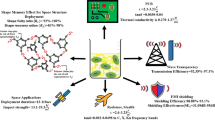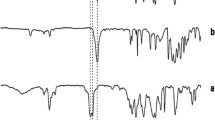Abstract
High-temperature organic polymers have been described [1] as polymers that retain useful properties after thousands of hours of exposure at 200°C in air under static conditions. However, as Hergenrother [1] pointed out this definition is misleading and varies considerably depending upon the supplier and user of the material. In many instances, temperature is reported without regard to other important factors that influence the performance of the polymer, such as thermal cycling, stress and environmental factors like moisture, or chemical and electrical action. In addition, polymers that can survive high-temperature processing cycles, but are otherwise not exposed to high temperatures, are also referred to as high-temperature polymers.
Access this chapter
Tax calculation will be finalised at checkout
Purchases are for personal use only
Preview
Unable to display preview. Download preview PDF.
Similar content being viewed by others
References
Hergenrother, P.M. (1990) Angew. Chem. Internat. Edit., 29, 1262.
Graver, R.B. (1986) Cyanate esters — high performance resins. In The Development of High Performance Polymers, eds. Seymour, R.B. and Kirshenbaum, G.S., Elsevier, New York and Amsterdam, p. 309.
Critchley, J.P., Knight, G.J. and Wright, W.W. (1983) Heat Resistant Polymers: Technologically Useful Materials. Plenum, London (and references cited therein).
Harris, B. (1991) Materials and Design, 12, 259.
Hergenrother, P.M. (1985) High temperature polymers from thermally curable oligomers, In Reactive Oligomers, eds. Harris, F.W. and Spinnelli, H.J., ACS Symposia Series, 282, 1.
Wilson, D., Stenzenberger, H.D. and Hergenrother, P.M. (eds.) (1990) Polyimides. Blackie, Glasgow.
Ellis, B. (ed.) (1993) The Chemistry and Technology of Epoxy Resins. Blackie Academic and Professional, Glasgow (and references cited therein).
Wright, W.W. (1991) Polymers in aerospace applications, Technical Report. Materials and Design, 12, 22.
Landman, D. (1986) Advances in the chemistry and applications of bis-maleimides, In Developments in Reinforced Plastics, vol. 5, ed. Pritchard, G., Applied Science, London, p. 39.
Graver, R.B. (1990) In International Encyclopaedia of Composites, vol. 1, ed. Lee, S.M., VCH, New York, p. 548.
Shimp, D.A., Christenson, J.R. and Ising, S.J. (1989) Int. SAMPE Symp. Exhibit. 34, 222.
McConnell, V.P. (1992) Advanced Composites May/June issue, p. 28.
Pankratov, V.A., Vinogradova, S.V. and Korshak, V.V. (1977) Russ. Chem. Rev., 46, 278.
Martin, D., Bauer, M. and Pankratov, V.A. (1978) Russ. Chem. Rev., 47, 975.
Cloez, S. (1857) C.R. Acad. Sci., 44, 482.
Grigat, E. and Pütter, R. (1967) Angew. Chem. Int. Edit., 6, 206.
Weirauch, K.K., Gemeinhardt, P.G. and Baron, A.L. (1976) Soc. Plast. Eng., Technical paper 22, 317.
Guku, M., Suzuki, K. and Nakamichi, K. (1978) US Patent 4,110,364.
Editor information
Editors and Affiliations
Rights and permissions
Copyright information
© 1994 Springer Science+Business Media Dordrecht
About this chapter
Cite this chapter
Hamerton, I. (1994). Introduction to cyanate ester resins. In: Hamerton, I. (eds) Chemistry and Technology of Cyanate Ester Resins. Springer, Dordrecht. https://doi.org/10.1007/978-94-011-1326-7_1
Download citation
DOI: https://doi.org/10.1007/978-94-011-1326-7_1
Publisher Name: Springer, Dordrecht
Print ISBN: 978-94-010-4577-3
Online ISBN: 978-94-011-1326-7
eBook Packages: Springer Book Archive




